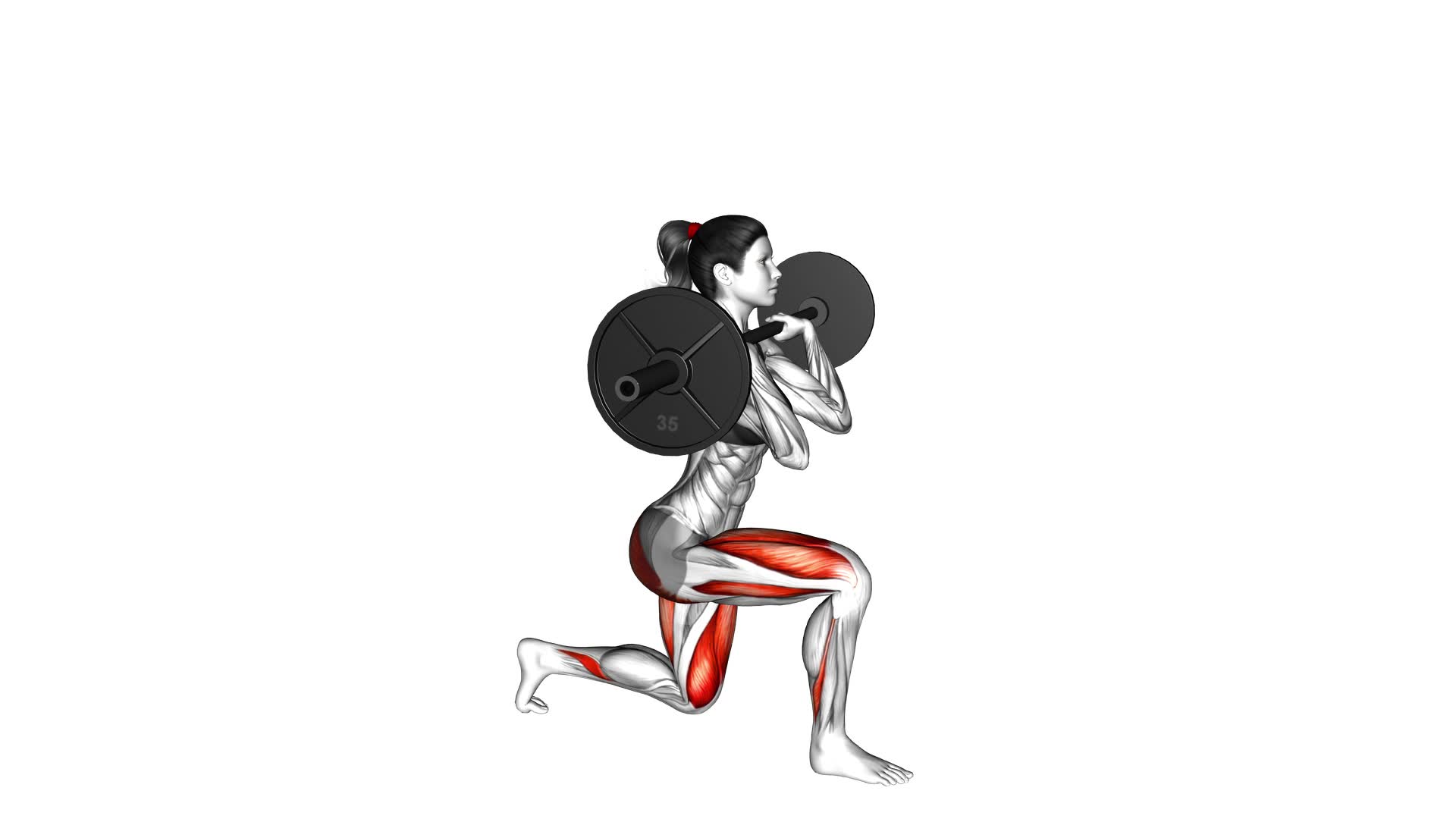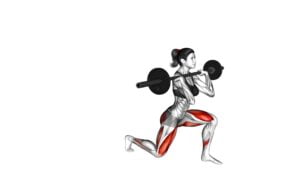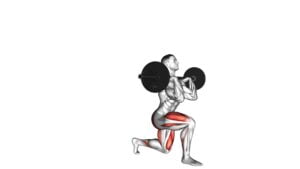Barbell Front Rack Split Squat (female) – Video Exercise Guide & Tips

Looking to strengthen your lower body while targeting your glutes, quads, and hamstrings? The barbell front rack split squat is the perfect exercise for you.
Watch This Exercise Video
In this video exercise guide, we'll show you the proper form and technique to execute this move effectively.
Plus, we'll provide variations to challenge yourself and tips for maximizing your workout.
Don't let common mistakes hinder your progress – learn how to avoid them and get the most out of your barbell front rack split squat routine.
Key Takeaways
- Barbell Front Rack Split Squat is highly effective for muscle activation and targets multiple muscle groups including glutes, quads, hamstrings, and calves.
- Maintaining proper form and technique is crucial, including keeping a stable and upright position, avoiding leaning forward or rounding the back, and keeping the knee aligned with the ankle.
- To challenge yourself, you can increase the weight of the barbell, perform the exercise on an unstable surface, use dumbbells instead of a barbell, or incorporate TRX suspension trainer or resistance bands.
- To get the most out of your workout, you can incorporate supersets, focus on compound exercises, include high-intensity interval training (HIIT), prioritize rest and recovery, and maximize calorie burn and cardiovascular fitness.
Benefits of Barbell Front Rack Split Squat
Get stronger and improve your lower body stability with the Barbell Front Rack Split Squat. This exercise is highly effective for muscle activation and offers various progression options to challenge yourself as you progress.
The Barbell Front Rack Split Squat primarily targets the muscles in your lower body, including the quadriceps, hamstrings, glutes, and calves. By placing the barbell across your upper chest and shoulders, you engage your core muscles for stability throughout the movement. This helps to improve your overall balance and coordination.
One of the main benefits of the Barbell Front Rack Split Squat is the high level of muscle activation it provides. It requires you to perform a deep lunge while maintaining an upright posture, which activates a large number of muscle fibers in your legs. This leads to improved strength and muscle development in your lower body.
Additionally, the Barbell Front Rack Split Squat offers a range of progression options. You can increase the weight of the barbell as you get stronger, or even incorporate other variations such as adding a pulse at the bottom of the movement or incorporating a jump at the top. These progressions allow you to continue challenging your muscles and making progress over time.
Proper Form and Technique
To ensure proper form and technique, you should focus on maintaining a stable and upright position throughout the Barbell Front Rack Split Squat exercise. This exercise targets your quads, glutes, and hamstrings while also improving your balance and stability.
It's important to avoid common errors such as leaning forward, rounding your back, or allowing your knee to cave inwards. To prevent these mistakes, make sure to keep your chest up, your core engaged, and your back straight throughout the movement.
Additionally, ensure that your front knee stays aligned with your ankle and doesn't go past your toes. If you're struggling with balance or stability, you can modify the exercise by performing it without the barbell or using a lighter weight. Remember to start with proper form and gradually increase the weight as you become more comfortable and confident.
Variations to Challenge Yourself
To further challenge yourself, you can explore different variations of the Barbell Front Rack Split Squat exercise. These advanced modifications won't only test your strength and stability but also help you break through plateaus in your fitness journey.
One option is to increase the weight of the barbell you're using. This will require your muscles to work harder and adapt to the increased load.
Another option is to perform the exercise on an unstable surface, such as a BOSU ball or a balance board. This will engage your core muscles even more and improve your overall balance and coordination.
Additionally, you can try performing the exercise with dumbbells instead of a barbell. This will challenge your muscles in a different way and provide a new stimulus for growth.
When it comes to equipment options, you can also experiment with using a TRX suspension trainer or resistance bands to add variety and intensity to the exercise.
By incorporating these advanced modifications and equipment options, you can take your Barbell Front Rack Split Squat to the next level and continue to progress in your fitness journey.
Now let's move on to some tips for getting the most out of your workout.
Tips for Getting the Most Out of Your Workout
Maximize your workout results with these effective tips.
When it comes to maximizing results, time-saving workouts are key.
One way to save time and increase the intensity of your workouts is by incorporating supersets. Supersets involve performing two exercises back to back without rest. This not only saves time but also keeps your heart rate elevated, leading to increased calorie burn and improved cardiovascular fitness.
Another tip is to focus on compound exercises that target multiple muscle groups at once. Exercises like squats, deadlifts, and push-ups engage multiple muscles, allowing you to get more done in less time.
Additionally, incorporating high-intensity interval training (HIIT) into your routine can help maximize your results. HIIT involves short bursts of intense exercise followed by periods of rest. This type of training has been shown to increase calorie burn and improve overall fitness in a shorter amount of time compared to steady-state cardio.
Lastly, don't forget to prioritize rest and recovery. Adequate rest allows your muscles to repair and grow, leading to improved strength and performance.
Common Mistakes to Avoid
One common mistake to avoid during the Barbell Front Rack Split Squat is not maintaining proper form. Proper form is essential to prevent injuries and maximize the effectiveness of the exercise. One mistake people often make is leaning too far forward during the movement. This can put excessive strain on the knees and lower back. To avoid this, focus on keeping your chest upright and your core engaged throughout the exercise.
Another common mistake is not using the proper weight. It's important to choose a weight that challenges you but still allows you to maintain good form. Starting with a lighter weight and gradually increasing it as you get stronger is a smart approach.
Additionally, it's important to avoid rushing through the exercise. Take your time and focus on performing each rep with control and precision.
Lastly, not incorporating modifications and progressions into your training can hinder your progress. As you become more comfortable with the Barbell Front Rack Split Squat, consider adding variations such as using dumbbells or kettlebells to further challenge your muscles.
Remember to always prioritize proper form and listen to your body to avoid injury and achieve optimal results.
Frequently Asked Questions
How Many Calories Can I Expect to Burn During a Barbell Front Rack Split Squat Workout?
During a barbell front rack split squat workout, you can expect to burn a significant amount of calories. This exercise engages multiple muscle groups, including your legs, glutes, and core, which leads to a higher calorie burn.
Additionally, barbell front rack split squats improve strength, balance, and flexibility. Incorporating this exercise into your fitness routine can help you achieve your calorie burn goals while reaping the benefits of a well-rounded workout.
Can I Perform Barbell Front Rack Split Squats if I Have Knee Pain or Injuries?
If you have knee pain or injuries, it's important to prioritize your safety and avoid exercises that aggravate your condition. Barbell front rack split squats can put a lot of pressure on the knees, so it might be best to find alternative exercises that don't cause discomfort.
However, if you have no knee issues, barbell front rack split squats can offer numerous benefits like strengthening your legs, improving balance, and targeting your glutes and quadriceps.
Should I Use a Lifting Belt While Performing Barbell Front Rack Split Squats?
When performing barbell front rack split squats, you may wonder if it's necessary to use a lifting belt. Using a lifting belt is a personal choice and not specifically required for this exercise.
However, if you've found benefits from using a lifting belt for other exercises, it may provide additional support and stability during the barbell front rack split squats.
It's important to listen to your body and use proper form to prevent any potential injuries.
Can I Substitute Dumbbells for a Barbell in the Barbell Front Rack Split Squat Exercise?
Yes, you can substitute dumbbells for a barbell in the barbell front rack split squat exercise. This variation allows for more stability and control, as well as targeting each leg independently.
Using a barbell has its benefits. It requires more core stability and helps to develop overall strength and power.
It's important to choose the variation that suits your goals and preferences. Remember to maintain proper form and gradually increase weight for progress.
How Long Should I Rest Between Sets During a Barbell Front Rack Split Squat Workout?
When performing a barbell front rack split squat workout, it's important to find the right rest duration between sets. Resting for around 60-90 seconds allows your muscles to recover without losing intensity. This gives you enough time to catch your breath and refocus for the next set.
Remember to maintain proper form throughout the exercise, keeping your front knee aligned with your toes and your back knee close to the floor.
Conclusion
In conclusion, the barbell front rack split squat is a beneficial exercise for women that targets the lower body and improves strength and stability.
By following proper form and technique, you can effectively challenge yourself and maximize the results of your workout.
Remember to avoid common mistakes and utilize variations to keep your routine engaging.
With dedication and consistency, you can achieve your fitness goals with this exercise.

Author
Years ago, the spark of my life’s passion ignited in my mind the moment I stepped into the local gym for the first time. The inaugural bead of perspiration, the initial endeavor, the very first surge of endorphins, and a sense of pride that washed over me post-workout marked the beginning of my deep-seated interest in strength sports, fitness, and sports nutrition. This very curiosity blossomed rapidly into a profound fascination, propelling me to earn a Master’s degree in Physical Education from the Academy of Physical Education in Krakow, followed by a Sports Manager diploma from the Jagiellonian University. My journey of growth led me to gain more specialized qualifications, such as being a certified personal trainer with a focus on sports dietetics, a lifeguard, and an instructor for wellness and corrective gymnastics. Theoretical knowledge paired seamlessly with practical experience, reinforcing my belief that the transformation of individuals under my guidance was also a reflection of my personal growth. This belief holds true even today. Each day, I strive to push the boundaries and explore new realms. These realms gently elevate me to greater heights. The unique combination of passion for my field and the continuous quest for growth fuels my drive to break new ground.







